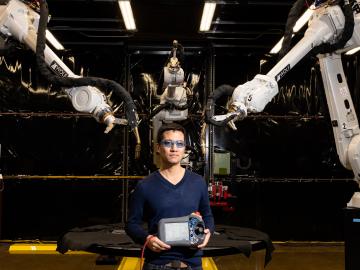
Filter News
Area of Research
- (-) Energy Science (62)
- (-) Nuclear Science and Technology (3)
- Advanced Manufacturing (12)
- Biology and Environment (24)
- Building Technologies (1)
- Computational Biology (1)
- Computational Engineering (2)
- Computer Science (5)
- Electricity and Smart Grid (1)
- Fusion and Fission (7)
- Fusion Energy (6)
- Isotopes (12)
- Materials (18)
- Materials for Computing (2)
- Mathematics (1)
- National Security (9)
- Neutron Science (3)
- Quantum information Science (1)
- Sensors and Controls (1)
- Supercomputing (5)
News Type
News Topics
- (-) 3-D Printing/Advanced Manufacturing (33)
- (-) Biomedical (3)
- (-) Biotechnology (1)
- (-) Clean Water (5)
- (-) Fusion (2)
- (-) Grid (20)
- (-) Isotopes (1)
- (-) Machine Learning (2)
- (-) Physics (1)
- (-) Security (2)
- Advanced Reactors (5)
- Artificial Intelligence (1)
- Big Data (2)
- Bioenergy (4)
- Biology (3)
- Buildings (19)
- Chemical Sciences (1)
- Composites (9)
- Computer Science (10)
- Coronavirus (6)
- Critical Materials (5)
- Cybersecurity (2)
- Energy Storage (31)
- Environment (21)
- High-Performance Computing (1)
- Hydropower (2)
- Materials (14)
- Materials Science (10)
- Mathematics (2)
- Mercury (2)
- Microscopy (3)
- Molten Salt (3)
- Nanotechnology (1)
- National Security (1)
- Neutron Science (3)
- Nuclear Energy (13)
- Polymers (5)
- Simulation (1)
- Space Exploration (3)
- Statistics (1)
- Summit (1)
- Transportation (36)
Media Contacts

Researchers at Oak Ridge National Laboratory developed a method that uses machine learning to predict seasonal fire risk in Africa, where half of the world’s wildfire-related carbon emissions originate.

Ada Sedova’s journey to Oak Ridge National Laboratory has taken her on the path from pre-med studies in college to an accelerated graduate career in mathematics and biophysics and now to the intersection of computational science and biology

Oak Ridge National Laboratory researchers have discovered a better way to separate actinium-227, a rare isotope essential for an FDA-approved cancer treatment.

Researchers at Oak Ridge National Laboratory demonstrated a 20-kilowatt bi-directional wireless charging system on a UPS plug-in hybrid electric delivery truck, advancing the technology to a larger class of vehicles and enabling a new energy storage method for fleet owners and their facilities.

As a teenager, Kat Royston had a lot of questions. Then an advanced-placement class in physics convinced her all the answers were out there.

Researchers at ORNL demonstrated that sodium-ion batteries can serve as a low-cost, high performance substitute for rechargeable lithium-ion batteries commonly used in robotics, power tools, and grid-scale energy storage.

Peter Wang is focused on robotics and automation at the Department of Energy’s Manufacturing Demonstration Facility at ORNL, working on high-profile projects such as the MedUSA, a large-scale hybrid additive manufacturing machine.

To better determine the potential energy cost savings among connected homes, researchers at Oak Ridge National Laboratory developed a computer simulation to more accurately compare energy use on similar weather days.

While Tsouris’ water research is diverse in scope, its fundamentals are based on basic science principles that remain largely unchanged, particularly in a mature field like chemical engineering.

As scientists study approaches to best sustain a fusion reactor, a team led by Oak Ridge National Laboratory investigated injecting shattered argon pellets into a super-hot plasma, when needed, to protect the reactor’s interior wall from high-energy runaway electrons.


